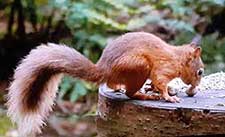
Garden pests then and now
I never knew of foxes or squirrels being farm or garden pests while I was growing up in the 1940s and 50s. Today, they have become serious pests in the garden.
Red squirrels in the good old days before the grey arrived

A red squirrel photographed in Scotland
In my childhood in the 1940s I never saw a grey squirrel. Yet I am told that authorities did recognise their incipient danger as pests because even at that time a shilling was paid to anyone who could confirm a killing by bringing in a grey squirrel's tail. It didn't last. Either it was too difficult to catch the squirrels or it became too expensive.
Squirrels strip the bark from trees to feed on sap which can have an adverse effect on trees, making them susceptible to fungal infections. Unlike reds, grey squirrels have high population densities so can cause significantly more damage to trees. Studies also show that grey squirrels are directly competing with birds that rely on deciduous trees for food and nesting sites.
Back in the 1940s, it was entirely normal to see red squirrels scampering around. People liked them and as far as I know, no-one complained of them being pests. Now, they have been replaced by grey squirrels in almost all parts of the country. They cause a great deal of damage to trees, plants and gardens generally.
Foxes' smaller numbers and timidity in the past
It was quite rare to see a fox when I was a child, even when walking in open countryside in rural areas. This was in the 1940s and early 1950s.

A fox
We did glimpse a fox from time to time, but it was a talking point, "Look everyone, a fox!". As soon as the fox saw us, it would stand stock still for an instant and then dart rapidly away in the opposite direction or behind a bush. This was so, even if we were already quite a distance away. Foxes were naturally scared of humans.
Foxes have changed their temperament since the 1940s and 50s. People laugh when I say this, but it is no joke. As I write in the third decade of the 21st century, foxes come into our back garden in increasing numbers. If they see us there, they still stand quite motionless, but no longer for an instant. They stay and glower directly at us, as if trying to stare us out. If we stare back, they eventually carry on calmly walking in their original direction.
If we shoo the foxes of today, they do amble away, but if we didn't see them in time to shoo, I am certain that they would come into the house. In fact there have been cases of this reported in the media. There have even been high profile cases of foxes biting humans inside their own homes.
It is impossible to keep them out of the garden as I have seen them clamber over six foot fences and even walk along snow covered tops of fences. I am told that they can climb up quite high trees, although I have never seen this. They can certainly stand on their hind legs to reach for low plums.
We now have to keep downstairs doors and windows shut.
Rabbits
Wild rabbits were a significant pest to farmers even though they were welcomed as a free source of meat.
I also understand that it was not unusual for the man of a household to own a shotgun to keep pests down. So probably there was little rabbit damage to gardens. Not so now - but my family will not own a shotgun. So we cannot grow ground-hugging vegetables or even certain flowers because of rabbit damage.
That said, it is nice to see the rabbits scampering around.
Guest contribution
Wild rabbits for food in wartime
On other pages, I describe how rabbits emerged as the corn was cut at harvest time, and how my young friends and I would chase them and the farmer would share them out for meat. I also describe watching my father on a shoot.
Neil Cryer
Pigeon pests
Protecting cabbages etc from pigeons was a major problem.
Netting was available but was made of a string-like material
that would
weaken and rot it kept damp, rather than the modern plastics which stand up
to all weathers and don't rot.
Nowadays pigeons actually eat the leaves of plum trees, making the trees too weak to bear plums.
Crow scarers
Crow scarers were used by farmers to scare off pigeons. They were specially adapted fireworks that made a loud bang every so often. They consisted of a long length of slow burning fuse with banger type fireworks distributed along the length. Once the end of the fuse was lit the result was a loud bang each time the burning part of the fuse reached one of these attached bangers. The resulting bangs were about half an hour apart and could carry on all day.
sources: early 20th century material
sources: ww2 home front and other material
contact
the webmaster/author/researcher/editor
privacy policy
















